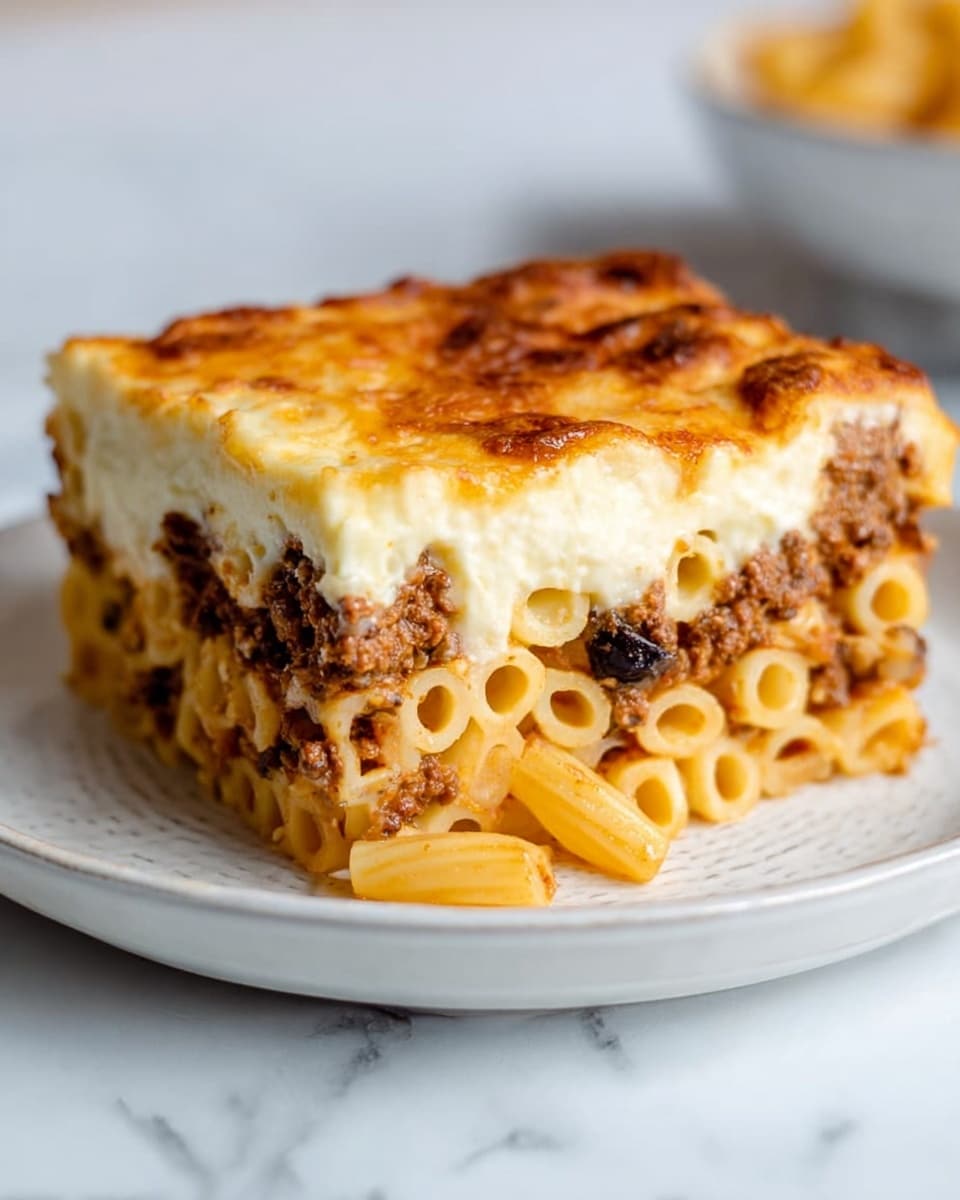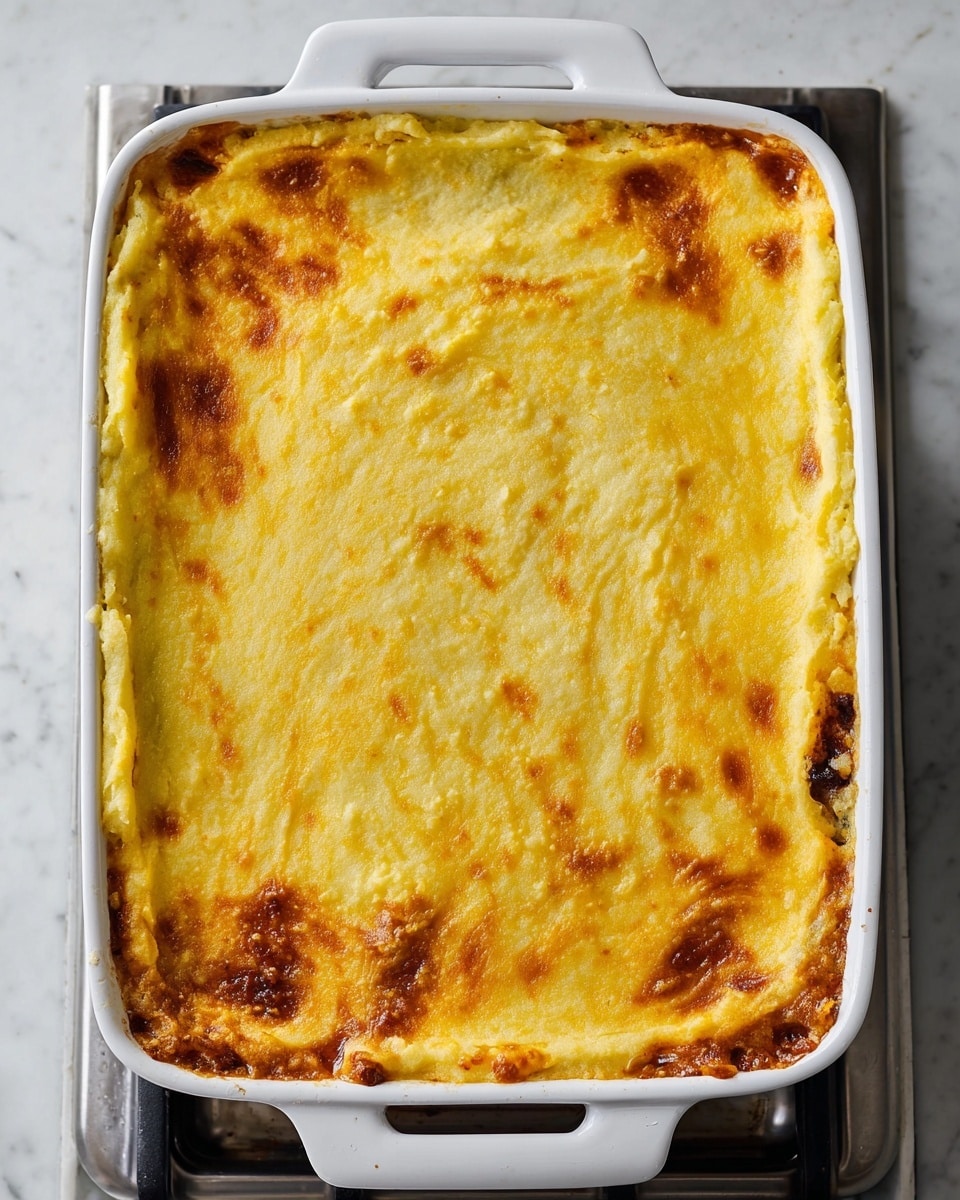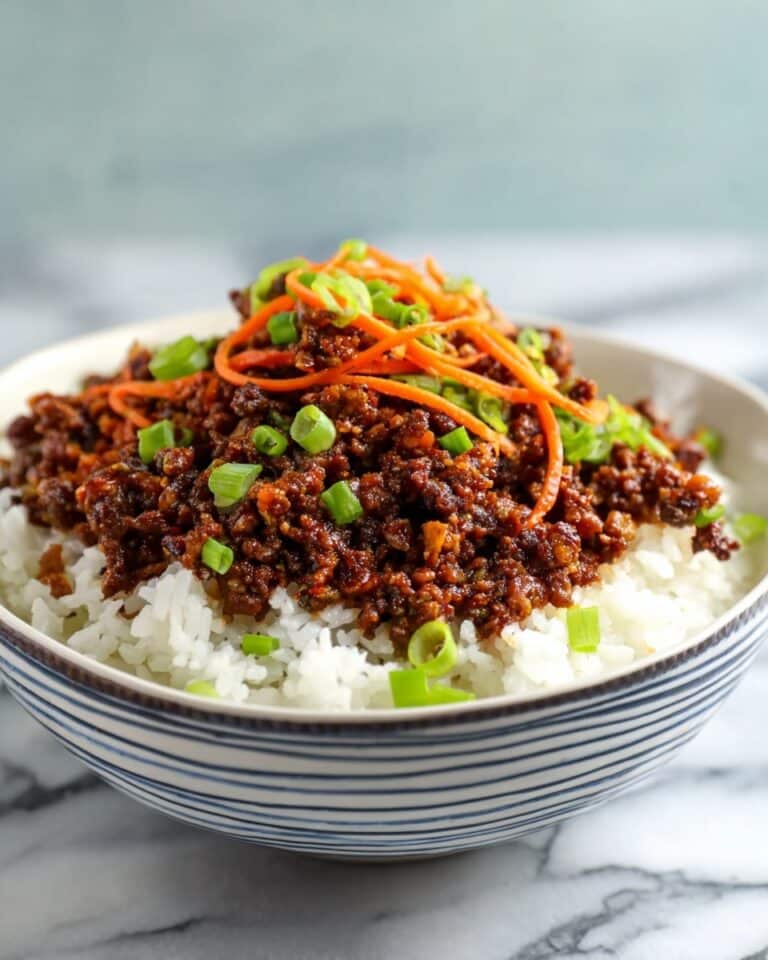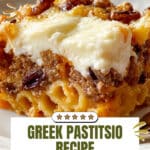Authentic Greek Pastitsio Recipe
If you’ve ever dreamed of making a Greek comfort food classic that feels like a warm hug on a plate, this Authentic Greek Pastitsio Recipe is exactly what you need. I first tried my hand at pastitsio during a visit to Greece, and the layers of rich meat sauce, creamy béchamel, and perfectly tender pasta instantly stole my heart. It’s special because it’s more than just a meal; it’s a celebration of bold flavors and family gatherings, and trust me, it’s perfect for feeding a hungry crowd or savoring leftovers all week long.
What makes this Authentic Greek Pastitsio Recipe stand out is its balance of spices and textures — the cinnamon and nutmeg add a subtle warmth to the savory meat sauce, while the cheese-infused béchamel makes every bite velvet-smooth. If you’re looking for a dish that impresses but isn’t complicated, and that tastes like it’s been slow-cooked with love, you’re going to enjoy making this as much as eating it.
Why This Recipe Works
- Layered Flavor Harmony: The combination of cinnamon, nutmeg, and herbs brings authentic Greek warmth that perfectly complements the savory meat and creamy béchamel.
- Classic Cheese Blend: Using Kefalotyri or Pecorino cheese adds a uniquely sharp and salty punch that makes the sauce irresistible.
- Simple Technique: Despite its gourmet taste, the recipe uses straightforward steps that anyone can follow for a fail-proof pastitsio.
- Perfect for Any Occasion: This dish scales well for family dinners, celebrations, or meal prepping — always delivering rich flavor and satisfying texture.
Ingredients & Why They Work
Each ingredient in this Authentic Greek Pastitsio Recipe plays an important role — from creating a deeply savory meat sauce to the luscious, cheesy béchamel that binds everything together. Using fresh herbs and traditional Greek cheeses really elevates this dish and makes your version taste genuinely authentic.
- Red onion: Provides sweetness and a soft base flavor when sautéed slowly.
- Garlic cloves: A must-have aromatic that infuses the meat sauce with depth.
- Olive oil: Greek cooking staple that adds richness and helps soften the aromatics.
- Ground beef: The hearty protein foundation for the meat sauce, I like using lean to balance flavor and fat.
- Red wine: Adds acidity and complexity — deglazing with it is a game changer for your sauce.
- Crushed tomato: Delivers bright, tangy flavor that simmers beautifully with spices.
- Fresh parsley: Offers freshness that lightens and brightens the robust sauce.
- Spices (white pepper, nutmeg, oregano, thyme, cinnamon, bay leaves): Classic Greek seasonings that make the meat sauce unforgettable with their warm, layered notes.
- Granulated sugar: Balances out acidity from tomatoes and wine for smooth richness.
- Whole milk, unsalted butter, flour: The base for your béchamel — creamy and thick with a slight buttery flavor.
- Kefalotyri or Pecorino cheese: Sharp, salty cheese that melts into the béchamel creating depth and a slight tang.
- Egg yolks: Enrich the béchamel, adding silkiness and helping the topping set during baking.
- Long ziti or pastitsio pasta: Traditional choice for that perfect tubular shape which holds sauce beautifully.
- Egg whites and feta cheese: Mixed with the pasta for extra moisture and saltiness, enhancing texture and flavor.
- Kosher salt: Essential for bringing all the flavors alive at each stage.
Tweak to Your Taste
One of the things I love about this Authentic Greek Pastitsio Recipe is how adaptable it can be — feel free to adjust the spices or cheeses to suit your preferences or what you have on hand. Playing with textures or making it lighter or richer has always been a fun experiment in my kitchen.
- Ground lamb variation: Swapping beef for lamb adds a gamey richness that takes the meat sauce to a celebratory level, especially around holidays.
- Dairy-free tweak: I’ve tried using plant-based milk and vegan cheese for béchamel, and while it’s not traditional, it works well for those avoiding dairy.
- Spice level: If you like a little kick, adding a pinch of red pepper flakes to the meat sauce is a simple way to personalize it.
- Pasta choice: While long ziti is classic, penne pasta is an easy substitute that still traps sauce in every bite.
Step-by-Step: How I Make Authentic Greek Pastitsio Recipe
Step 1: Sauté Aromatics & Brown the Beef
Start by gently cooking your chopped red onion and minced garlic in olive oil over medium-high heat until they become golden and fragrant — usually about 3 to 5 minutes. This step builds the flavor base for your sauce, so don’t rush it. Then, add the ground beef, breaking it up evenly in the pan. Season with kosher salt and cook until it’s nicely browned, which should take about 8 to 10 minutes. The browning adds a savory depth you won’t want to miss.
Step 2: Deglaze & Simmer the Meat Sauce
Once the beef is browned, pour in the red wine to deglaze the pan. Let it reduce by half — this concentrates the flavor and lifts all those tasty browned bits from the pan. Next, stir in crushed tomatoes, fresh parsley, and all your spices: white pepper, sugar, nutmeg, oregano, thyme, cinnamon, and bay leaves. Let this sauce simmer gently for 45 to 60 minutes. Stir occasionally and keep an eye on it so it doesn’t stick. This slow simmering is what makes the sauce rich and complex.
Step 3: Cook Pasta & Mix with Egg Whites and Feta
Boil your pasta in plenty of salted water until it’s just al dente — you want a slight bite since it will bake again later. Drain well and transfer the pasta to a 9×13 casserole dish. While still warm, toss the pasta with the egg whites and crumbled feta cheese immediately. This step lightly binds the pasta together and adds creamy, tangy pockets of flavor that cut beautifully through the hearty meat sauce.
Step 4: Make the Classic Cheese Béchamel
To make the béchamel, melt the butter over low heat in a saucepan. Stir in the flour and cook for about 1 minute to cook out the raw taste, stirring constantly. Then, gradually whisk in the milk and bring it to a boil. Lower the heat and add your grated Kefalotyri or Pecorino cheese, whisking until smooth and creamy. Remove from heat, then quickly whisk in the egg yolks. This creamy béchamel is what turns your pastitsio into that classic silky, golden-topped masterpiece.
Step 5: Assemble & Bake to Golden Perfection
Spread the meat sauce evenly over the pasta layer in your baking pan. Don’t be shy—get that sauce all the way to the edges to keep every bite delicious. Then pour the béchamel sauce gently over the top, filling to the brim for that stunning thick top layer. Bake in a 400˚F oven for about 30 minutes or until the béchamel is a gorgeous golden brown. After baking, let it rest for at least 15 minutes — I know it’s tempting to dig in, but patience helps the layers set beautifully for clean slices.
Pro Tips for Making Authentic Greek Pastitsio Recipe
- Simmer Low and Slow: Don’t rush the meat sauce—slow simmering unlocks layers of flavor, so aim for 45 minutes or more if you can.
- Use Freshly Grated Cheese: Pre-grated cheese often contains additives that prevent smooth melting, so grate your Kefalotyri or Pecorino fresh for the creamiest béchamel.
- Don’t Skip the Resting Time: Letting the pastitsio cool before slicing helps keep the layers intact and makes serving so much neater.
- Egg Yolks in Béchamel: Whisk in egg yolks off the heat to enrich the sauce without curdling, giving it that silky texture everyone loves.
How to Serve Authentic Greek Pastitsio Recipe
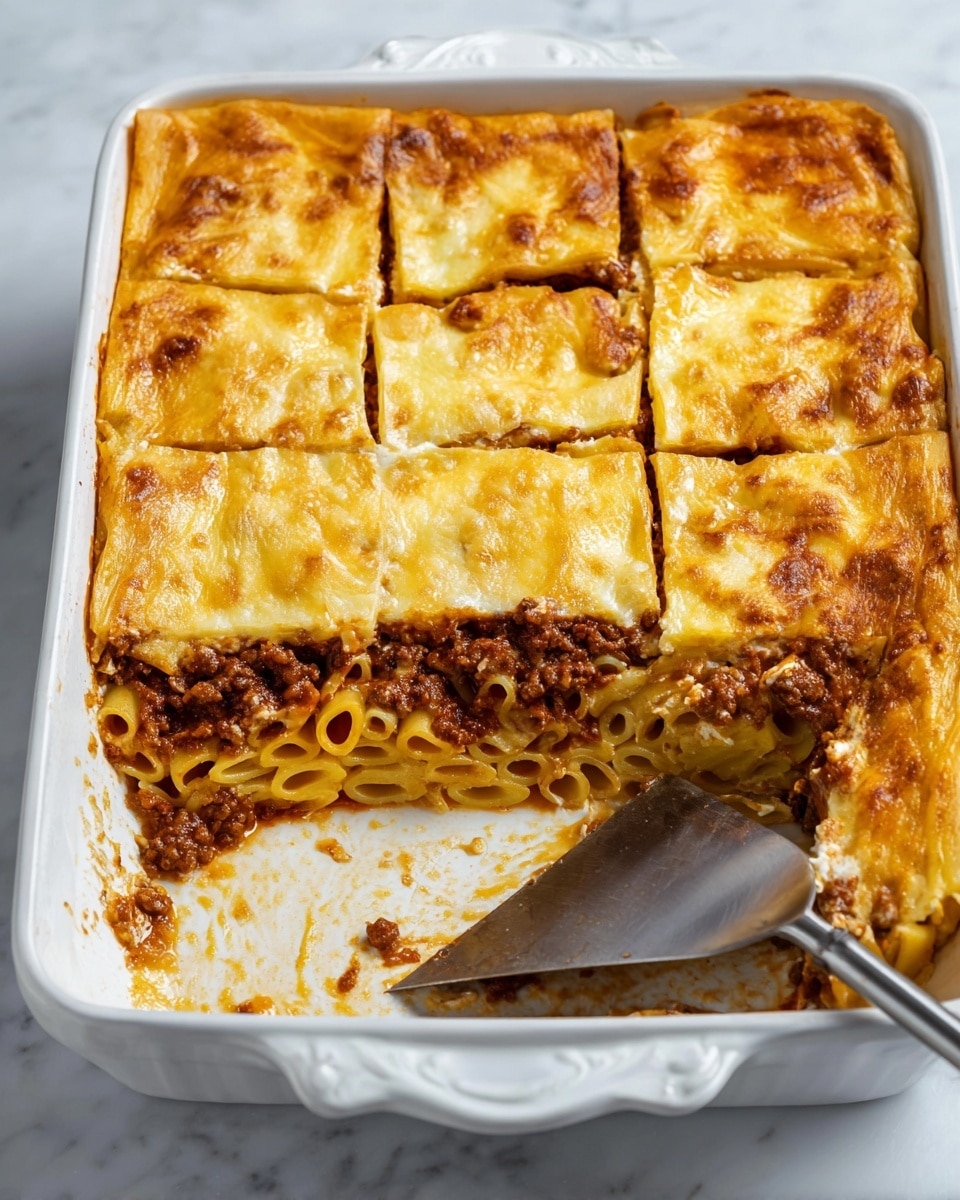
Garnishes
I usually sprinkle a bit of freshly chopped parsley or oregano just before serving; it adds a fresh pop of color and light herbaceousness. Sometimes I crumble extra feta on top for guests who love that sharp salty flavor. A little cracked black pepper right before plating also brightens long savory bites perfectly.
Side Dishes
This pastitsio pairs beautifully with a simple Greek salad—think ripe tomatoes, cucumbers, olives, and red onion tossed with olive oil and lemon juice. Roasted vegetables or a side of lemony steamed greens like spinach or broccoli also make a refreshing counterpoint to the rich, cheesy main dish.
Creative Ways to Present
For holiday dinners or when I want to impress, I bake the pastitsio in individual ramekins for charming single servings. It’s also fun to sprinkle some toasted pine nuts on top before baking for an unexpected crunch and nutty flavor that pairs so well with Greek spices.
Make Ahead and Storage
Storing Leftovers
I usually let the pastitsio cool completely, then cover tightly with foil or plastic wrap and refrigerate. It keeps beautifully for up to 4 days, which is great if you want ready meals for busy nights. I always find it tastes even better the next day as the flavors have more time to meld.
Freezing
This recipe freezes exceptionally well! I portion pastitsio into airtight containers or wrap individual slices tightly in foil and plastic wrap to avoid freezer burn. When I thaw it overnight in the fridge, the texture holds up nicely, and the flavors stay just as vibrant.
Reheating
I recommend reheating pastitsio in the oven to maintain the creamy texture and avoid drying it out—cover loosely with foil and warm at 350˚F for 20-25 minutes until heated through. If you’re in a hurry, a microwave works too but watch the time carefully and add a splash of milk before heating to keep it moist.
FAQs
-
Can I make Authentic Greek Pastitsio Recipe ahead of time?
Absolutely! In fact, the flavors often deepen if you assemble it a day before and bake it fresh or simply reheat it. You can also fully bake and refrigerate or freeze it, making it a convenient option for meal prep or entertaining.
-
What type of pasta is best for pastitsio?
Traditional pastitsio uses long tubular pasta like long ziti or a specific Greek pastitsio pasta. Penne is a good substitute if you can’t find those. The key is pasta that holds sauce well inside its tubes for that perfect bite.
-
Can I use a different cheese if I can’t find Kefalotyri or Pecorino?
Yes, you can substitute with sharp aged Parmesan or Asiago, but avoid mild cheeses since the béchamel needs a strong, salty profile to balance the dish.
-
Is pastitsio hard to make?
It can seem intimidating due to multiple steps, but the process is very manageable with some planning. Take your time with the meat sauce and béchamel, and the assembly is straightforward. It’s actually a great recipe to build confidence in layering and sauce-making techniques.
Final Thoughts
This Authentic Greek Pastitsio Recipe holds a special place in my heart because it reminds me of family dinners full of laughter, stories, and second helpings. It’s one of those dishes where the effort truly pays off in every bite — creamy, hearty, and just bursting with those warm, comforting Greek flavors. If you’re ready to impress your loved ones or simply enjoy a soulful meal, I can’t recommend making pastitsio enough. Once you try it, I bet you’ll find it becoming a cherished staple in your home, just like it did in mine.
Print
Authentic Greek Pastitsio Recipe
- Prep Time: 20 minutes
- Cook Time: 1 hour 30 minutes
- Total Time: 1 hour 50 minutes
- Yield: 10 servings
- Category: Main Course
- Method: Baking
- Cuisine: Greek
- Diet: Halal
Description
Authentic Greek Pastitsio is a classic baked pasta dish featuring layers of tender pasta mixed with feta and egg whites, a rich, slow-simmered beef and tomato meat sauce infused with warm spices, and topped with a creamy, cheesy béchamel sauce. This hearty and comforting main course is perfect for family dinners and special occasions.
Ingredients
Meat Sauce
- 1 red onion, chopped
- 3 garlic cloves, minced
- 2 tablespoons olive oil
- 2 lbs. ground beef
- 1 cup red wine
- 28 oz. can crushed tomato
- 1 cup fresh parsley, minced
- 1/2 teaspoon white pepper
- 2 teaspoons granulated sugar
- 1 teaspoon nutmeg
- 1 teaspoon dried oregano
- 1/2 teaspoon dried thyme
- 1/2 teaspoon cinnamon
- 3 bay leaves
- Kosher salt, to taste
Béchamel Sauce
- 4 cups whole milk
- 1/4 cup unsalted butter
- 1/2 cup flour
- 1 1/2 cups grated Kefalotyri or Pecorino cheese
- 2 egg yolks
- Kosher salt, to taste
Pasta
- 1 lb. long ziti, pastitsio pasta, or penne pasta
- 2 egg whites
- 7 oz. feta cheese
Instructions
- Cook the aromatics: In a wide pan over medium-high heat, add the olive oil, chopped red onion, and minced garlic. Cook for 3 to 5 minutes or until the onion is slightly golden and fragrant.
- Brown the beef: Add the ground beef to the pan and break it up evenly. Cook until browned, seasoning with kosher salt to taste.
- Deglaze with wine: Pour in the red wine to deglaze the pan, scraping up any browned bits, and reduce the liquid by half over medium heat.
- Add tomato and spices: Stir in the crushed tomatoes, fresh parsley, white pepper, granulated sugar, cinnamon, nutmeg, dried oregano, dried thyme, and bay leaves. Lower the heat and let the sauce simmer for 45 to 60 minutes until thickened. Remove from heat and discard bay leaves.
- Cook the pasta: Boil the pasta noodles in salted water until al dente. Drain thoroughly and place in a large 9×13 casserole pan with handles.
- Mix pasta with cheese and eggs: While the pasta is still hot, immediately toss it with the egg whites and crumbled feta cheese to evenly coat and bind the pasta.
- Make the béchamel sauce: In a pot over low heat, melt the unsalted butter. Stir in the flour and cook for about 1 minute, stirring constantly to form a roux. Gradually whisk in the whole milk and bring to a boil. Reduce heat to low and stir in the grated Kefalotyri or Pecorino until a smooth cheese sauce forms. Remove from heat, whisk in the egg yolks, and season with kosher salt to taste.
- Assemble the pastitsio: Pour the meat sauce evenly over the pasta layer in the casserole. Then pour the béchamel sauce over the top to the brim, smoothing the surface with a spatula.
- Bake: Place the casserole in a preheated oven at 400 degrees Fahrenheit. Bake for 30 minutes or until the béchamel topping is golden brown and bubbly.
- Rest and serve: Remove from the oven and let the pastitsio cool for 15 minutes before cutting into portions and serving.
Notes
- For the cheese, if Kefalotyri or Pecorino is unavailable, aged Parmesan can be a substitute.
- The slow simmer of the meat sauce is essential for deep flavor, so avoid rushing this step.
- Make sure the pasta is hot when mixing with eggs and feta to help the eggs lightly cook and bind the pasta.
- Use a 9×13 casserole dish to allow even layering and cooking.
- Letting the dish rest before serving helps the layers set and makes slicing easier.
Nutrition
- Serving Size: 1 slice (approximately 1/10 of recipe)
- Calories: 550 kcal
- Sugar: 8 g
- Sodium: 620 mg
- Fat: 25 g
- Saturated Fat: 12 g
- Unsaturated Fat: 10 g
- Trans Fat: 0.5 g
- Carbohydrates: 50 g
- Fiber: 4 g
- Protein: 35 g
- Cholesterol: 150 mg

